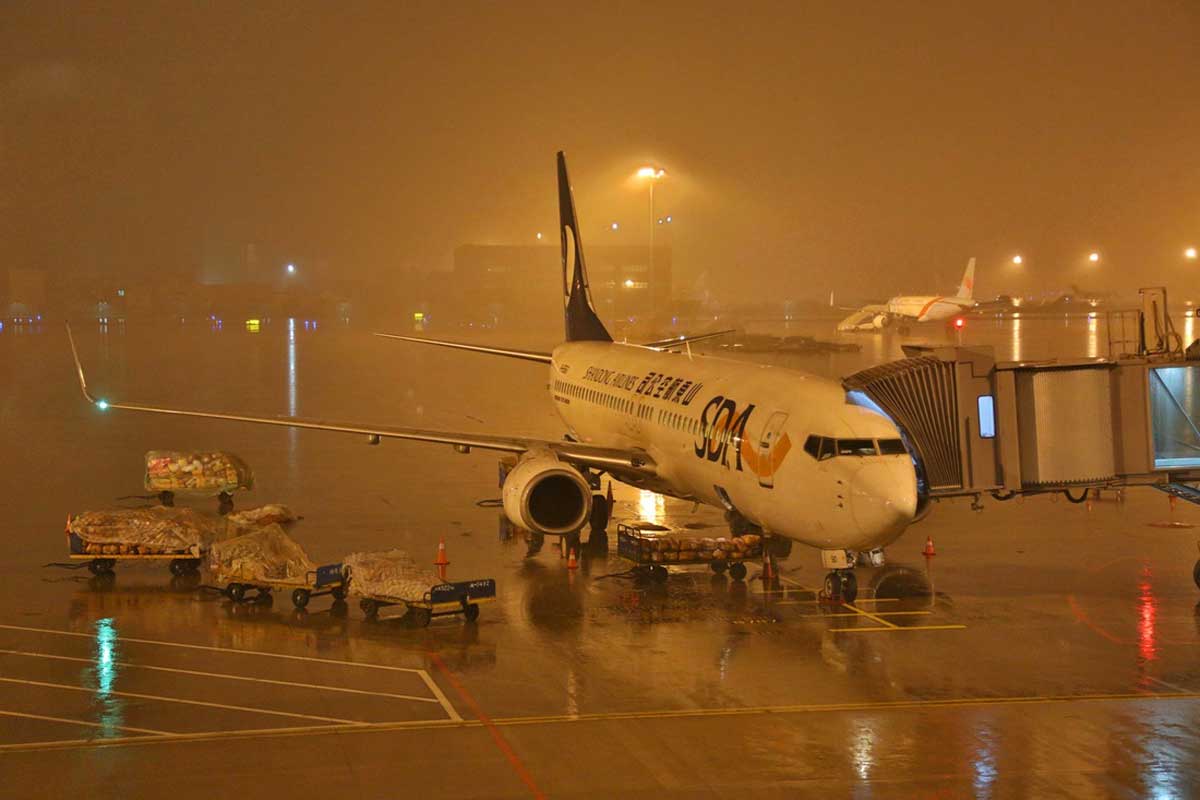In this part, you will tell me what you can see in this picture and what you think is happening in it. After that, I will ask you some questions. Look at the picture carefully. You may take a few moments to think before you start talking.
Are the instructions clear?
SUGGESTED INTERACTION:
ICAO 5: In this picture I can see a twin-engined passenger jet that appears to be a Boeing 737, operated by Shandong Airlines parked at the gate.
The jetway is connected and the lights are on, so the boarding or disembarking might be happening.
There are five dollies next to the aircraft which in my opinion will be loaded because the right cargo door is opened.
No doubt about it, It’s raining a lot and all the flights might be delayed because of bad weather.
ICAO 4: In this picture I can see a twin-engined passenger jet parked at the gate.
The jetway is connected to the aircraft for the boarding or disembarking of the passengers.
There are five dollies loaded next to the aircraft and the right cargo door is opened.
The ground is wet, the weather is rainy and the visibility is poor.
Examiner: What do you think happened before this picture was taken?
SUGGESTED INTERACTION:
ICAO 5: As I believe this aircraft is being prepared for departure, it landed under bad weather conditions to disembark and embark other passengers for the next leg.
ICAO 4: The aircraft landed under bad weather conditions to disembark and embark passengers.
Examiner: Imagine that this picture has just been taken: What do you think will happen next?
SUGGESTED INTERACTION:
ICAO 5: This aircraft is being prepared for the next leg and as soon as the weather gets better they will start the departure procedures.
ICAO 4: When everything is ready, the pilot will request pushback and startup, taxi instruction and departure clearance.
Examiner: What should a pilot do in order to land safely under bad weather conditions?
SUGGESTED INTERACTION:
ICAO 5: First of all pilots have to see if they have good conditions to land.
If so, they should get runway conditions information such as breaking action.
Pilots must consider if there’s ice, snow, slush or standing water on the runway and also request a PIREP to have a safe decision making for landing.
ICAO 4: To begin with, in bad weather operations, pilots should always check if the runway is in good condition to land safely.
Therefore, it is extremely important to obtain information about the length of the runway and the braking action.
.
Examiner: Why do pilots need to know what dangerous goods they are carrying and where they are in the aircraft?
SUGGESTED INTERACTION:
ICAO 5: It is extremely important that pilots know exactly what kind of dangerous goods they are transporting and where they are stored in the event of an incident on board.
Knowing this, in the event of a fire, for example, they will anticipate communicating to ATC so that the necessary emergency and fire services can be provided after landing to support them.
ICAO 4: Because in the event of an incident, such as a fire in the CARGO HOLD, for example, they will be able to anticipate the situation by communicating to ATC so that the necessary emergency and fire services are provided after landing to support them.
Now, I am going to read a statement to you and then you will have to tell me to what extent you agree or disagree with it.
“If the focus of dealing with dangerous goods training was on packaging and labeling instead of being on dealing with the operational aspects of the goods transportation, pilots would probably not respond to onboard incidents as effectively as they should.”
SUGGESTED INTERACTION
ICAO 5: I agree with this statement because every professional should focus on their exactly training areas.
Ground staff are trained and responsible for all the loading and storage of dangerous goods.
Pilots must be informed where they are, the amount of them and their nature.
Pilots must fly the aircraft carrying these goods very prepared for any incident happens on board by taking immediate and effective actions to land safely for assistance.
ICAO 4:
I agree with this statement because every professional should focus exactly on their areas of training.
Ground Staff are trained and responsible for all loading and storage of dangerous goods and for informing pilots where they are, the amount and the nature of these dangerous goods.
Aware of this, pilots will be prepared for any incident that may happen on board, by taking immediate and effective action to land safely for assistance.
Se você gostou desse post do Call to Fly, compartilhe utilizando os canais de Mídia!!
Abraço!! Rumo ao topo!
Leandro Araujo
